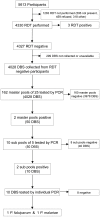Surveillance for malaria elimination in Swaziland: a national cross-sectional study using pooled PCR and serology
- PMID: 22238621
- PMCID: PMC3253098
- DOI: 10.1371/journal.pone.0029550
Surveillance for malaria elimination in Swaziland: a national cross-sectional study using pooled PCR and serology
Abstract
Background: To guide malaria elimination efforts in Swaziland and other countries, accurate assessments of transmission are critical. Pooled-PCR has potential to efficiently improve sensitivity to detect infections; serology may clarify temporal and spatial trends in exposure.
Methodology/principal findings: Using a stratified two-stage cluster, cross-sectional design, subjects were recruited from the malaria endemic region of Swaziland. Blood was collected for rapid diagnostic testing (RDT), pooled PCR, and ELISA detecting antibodies to Plasmodium falciparum surface antigens. Of 4330 participants tested, three were RDT-positive yet false positives by PCR. Pooled PCR led to the identification of one P. falciparum and one P. malariae infection among RDT-negative participants. The P. falciparum-infected participant reported recent travel to Mozambique. Compared to performing individual testing on thousands of samples, PCR pooling reduced labor and consumable costs by 95.5%. Seropositivity was associated with age ≥20 years (11·7% vs 1·9%, P<0.001), recent travel to Mozambique (OR 4.4 [95% CI 1.0-19.0]) and residence in southeast Swaziland (RR 3.78, P<0.001).
Conclusions: The prevalence of malaria infection and recent exposure in Swaziland are extremely low, suggesting elimination is feasible. Future efforts should address imported malaria and target remaining foci of transmission. Pooled PCR and ELISA are valuable surveillance tools for guiding elimination efforts.
Conflict of interest statement
Figures



References
-
- Alves FP, Gil LH, Marrelli MT, Ribolla PE, Camargo EP, et al. Asymptomatic carriers of Plasmodium spp. as infection source for malaria vector mosquitoes in the Brazilian Amazon. J Med Entomol. 2005;42:777–779. - PubMed

